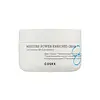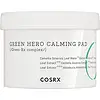What's inside
What's inside
 Key Ingredients
Key Ingredients

 Benefits
Benefits

 Concerns
Concerns

 Ingredients Side-by-side
Ingredients Side-by-side

Water
Skin ConditioningGlycerin
HumectantEthylhexyl Stearate
EmollientVinyldimethicone
Pentylene Glycol
Skin ConditioningCocos Nucifera Oil
Masking1,2-Hexanediol
Skin ConditioningCetearyl Alcohol
EmollientPanthenol
Skin ConditioningPolymethylsilsesquioxane
Arachidyl Alcohol
EmollientPropolis Extract
Skin ConditioningHydroxyethyl Acrylate/Sodium Acryloyldimethyl Taurate Copolymer
Emulsion StabilisingPolyglyceryl-6 Stearate
EmollientButylene Glycol
HumectantCarbomer
Emulsion StabilisingBehenyl Alcohol
EmollientGlyceryl Stearate
EmollientTromethamine
BufferingDimethiconol
EmollientCaprylyl Glycol
EmollientArachidyl Glucoside
EmulsifyingHydrogenated Lecithin
EmulsifyingCeramide NP
Skin ConditioningEthylhexylglycerin
Skin ConditioningXanthan Gum
EmulsifyingSucrose Stearate
EmollientPolyglyceryl-6 Behenate
Emulsion StabilisingSodium Polyacrylate Starch
AbsorbentStearic Acid
CleansingPalmitic Acid
EmollientSodium Hyaluronate
HumectantCholesterol
EmollientHyaluronic Acid
HumectantGlycosphingolipids
EmollientHydrolyzed Hyaluronic Acid
HumectantWater, Glycerin, Ethylhexyl Stearate, Vinyldimethicone, Pentylene Glycol, Cocos Nucifera Oil, 1,2-Hexanediol, Cetearyl Alcohol, Panthenol, Polymethylsilsesquioxane, Arachidyl Alcohol, Propolis Extract, Hydroxyethyl Acrylate/Sodium Acryloyldimethyl Taurate Copolymer, Polyglyceryl-6 Stearate, Butylene Glycol, Carbomer, Behenyl Alcohol, Glyceryl Stearate, Tromethamine, Dimethiconol, Caprylyl Glycol, Arachidyl Glucoside, Hydrogenated Lecithin, Ceramide NP, Ethylhexylglycerin, Xanthan Gum, Sucrose Stearate, Polyglyceryl-6 Behenate, Sodium Polyacrylate Starch, Stearic Acid, Palmitic Acid, Sodium Hyaluronate, Cholesterol, Hyaluronic Acid, Glycosphingolipids, Hydrolyzed Hyaluronic Acid
Camellia Sinensis Leaf Water
MaskingButylene Glycol
HumectantTaraxacum Officinale Leaf Extract
Skin ConditioningCentella Asiatica Extract
CleansingHamamelis Virginiana Leaf Extract
Skin ConditioningMelaleuca Alternifolia Leaf Extract
PerfumingArtemisia Princeps Extract
Skin Conditioning1,2-Hexanediol
Skin ConditioningCassia Obtusifolia Seed Extract
Skin ConditioningLactobionic Acid
BufferingMaltodextrin
AbsorbentPanthenol
Skin ConditioningPolyglyceryl-10 Laurate
Skin ConditioningPolyglyceryl-10 Myristate
Skin ConditioningGlycerin
HumectantArginine
MaskingAllantoin
Skin ConditioningAsiaticoside
AntioxidantAsiatic Acid
Skin ConditioningMadecassic Acid
Skin ConditioningSodium Hyaluronate
HumectantGardenia Florida Fruit Extract
Skin ConditioningCitrus Aurantium Bergamia Fruit Oil
MaskingMenthyl Lactate
MaskingMentha Haplocalix Extract
MaskingCamellia Sinensis Leaf Water, Butylene Glycol, Taraxacum Officinale Leaf Extract, Centella Asiatica Extract, Hamamelis Virginiana Leaf Extract, Melaleuca Alternifolia Leaf Extract, Artemisia Princeps Extract, 1,2-Hexanediol, Cassia Obtusifolia Seed Extract, Lactobionic Acid, Maltodextrin, Panthenol, Polyglyceryl-10 Laurate, Polyglyceryl-10 Myristate, Glycerin, Arginine, Allantoin, Asiaticoside, Asiatic Acid, Madecassic Acid, Sodium Hyaluronate, Gardenia Florida Fruit Extract, Citrus Aurantium Bergamia Fruit Oil, Menthyl Lactate, Mentha Haplocalix Extract
 Reviews
Reviews

Ingredients Explained
These ingredients are found in both products.
Ingredients higher up in an ingredient list are typically present in a larger amount.
1,2-Hexanediol is a synthetic liquid and another multi-functional powerhouse.
It is a:
- Humectant, drawing moisture into the skin
- Emollient, helping to soften skin
- Solvent, dispersing and stabilizing formulas
- Preservative booster, enhancing the antimicrobial activity of other preservatives
Butylene Glycol (or BG) is used within cosmetic products for a few different reasons:
Overall, Butylene Glycol is a safe and well-rounded ingredient that works well with other ingredients.
Though this ingredient works well with most skin types, some people with sensitive skin may experience a reaction such as allergic rashes, closed comedones, or itchiness.
Learn more about Butylene GlycolGlycerin is already naturally found in your skin. It helps moisturize and protect your skin.
A study from 2016 found glycerin to be more effective as a humectant than AHAs and hyaluronic acid.
As a humectant, it helps the skin stay hydrated by pulling moisture to your skin. The low molecular weight of glycerin allows it to pull moisture into the deeper layers of your skin.
Hydrated skin improves your skin barrier; Your skin barrier helps protect against irritants and bacteria.
Glycerin has also been found to have antimicrobial and antiviral properties. Due to these properties, glycerin is often used in wound and burn treatments.
In cosmetics, glycerin is usually derived from plants such as soybean or palm. However, it can also be sourced from animals, such as tallow or animal fat.
This ingredient is organic, colorless, odorless, and non-toxic.
Glycerin is the name for this ingredient in American English. British English uses Glycerol/Glycerine.
Learn more about GlycerinPanthenol is a common ingredient that helps hydrate and soothe the skin. It is found naturally in our skin and hair.
There are two forms of panthenol: D and L.
D-panthenol is also known as dexpanthenol. Most cosmetics use dexpanthenol or a mixture of D and L-panthenol.
Panthenol is famous due to its ability to go deeper into the skin's layers. Using this ingredient has numerous pros (and no cons):
Like hyaluronic acid, panthenol is a humectant. Humectants are able to bind and hold large amounts of water to keep skin hydrated.
This ingredient works well for wound healing. It works by increasing tissue in the wound and helps close open wounds.
Once oxidized, panthenol converts to pantothenic acid. Panthothenic acid is found in all living cells.
This ingredient is also referred to as pro-vitamin B5.
Learn more about PanthenolSodium Hyaluronate is hyaluronic acid's salt form. It is commonly derived from the sodium salt of hyaluronic acid.
Like hyaluronic acid, it is great at holding water and acts as a humectant. This makes it a great skin hydrating ingredient.
Sodium Hyaluronate is naturally occurring in our bodies and is mostly found in eye fluid and joints.
These are some other common types of Hyaluronic Acid:
Learn more about Sodium Hyaluronate